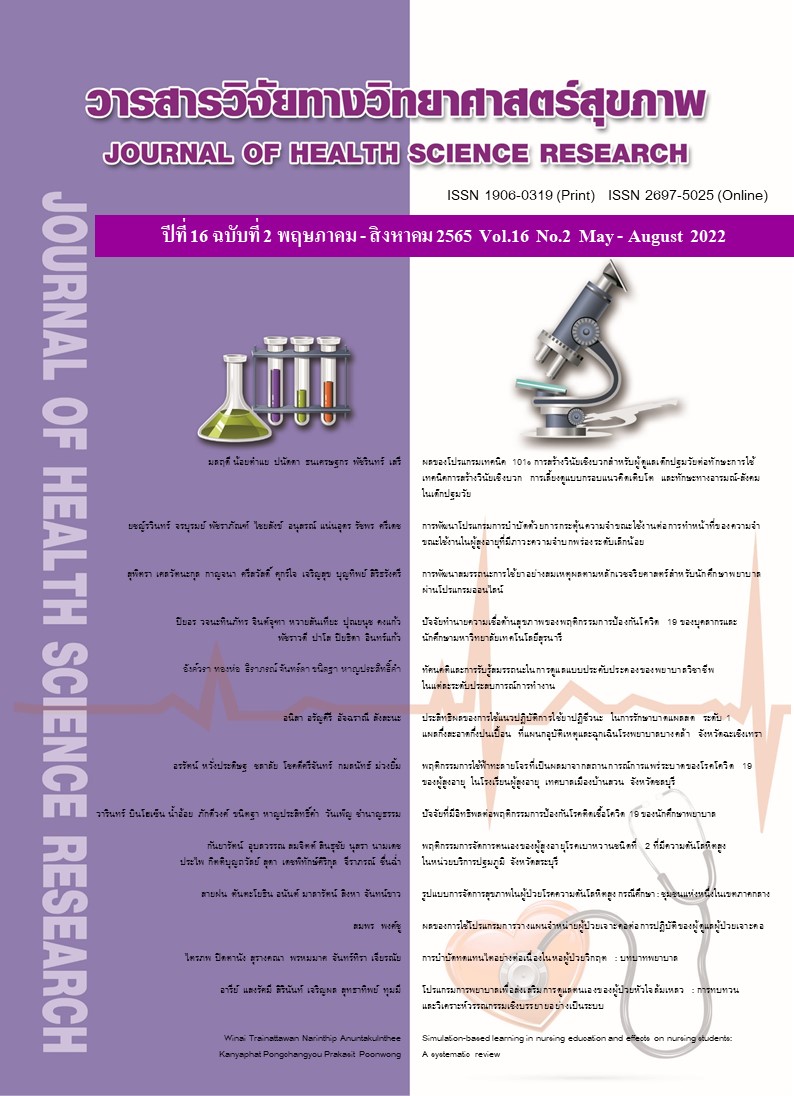ผลของการใช้โปรแกรมการวางแผนจำหน่ายผู้ป่วยเจาะคอ ต่อการปฏิบัติของผู้ดูแลผู้ป่วยเจาะคอ
Main Article Content
บทคัดย่อ
บทนำ : การเตรียมความพร้อมของผู้ดูแลผู้ป่วยเจาะคอมีผลต่อการป้องกันภาวะแทรกซ้อนจากการ
คาท่อเจาะคอ ในผู้ป่วยที่ได้รับการเจาะคอได้
วัตถุประสงค์การวิจัย : เพื่อศึกษาผลของโปรแกรมการวางแผนจำหน่ายผู้ป่วยเจาะคอต่อการปฏิบัติของผู้ดูแลผู้ป่วยเจาะคอ
วิธีการวิจัย : การวิจัยกึ่งทดลองแบบกลุ่มเดียววัดผลก่อนหลัง ตัวอย่างเป็นผู้ดูแลที่ดูแลผู้ป่วยเจาะคอ ที่เข้ารับการรักษาในหอผู้ป่วยอายุรกรรมและศัลยกรรม สถาบันบำราศนราดูร จำนวน 30 ราย ได้เข้าร่วมโปรแกรมเป็นเวลา 6 วัน เครื่องมือที่ใช้ในการวิจัย ประกอบด้วย โปรแกรมการวางแผนจำหน่ายผู้ป่วยเจาะคอ แบบบันทึกข้อมูลทั่วไปของผู้ดูแล แบบสอบถามความรู้ การปฏิบัติของผู้ดูแลผู้ป่วยเจาะคอ และแบบประเมินความพึงพอใจการใช้หุ่นจำลองท่อเจาะคอ โดยมีค่าเที่ยงเท่ากับ .85 และ.95 ตามลำดับ วิเคราะห์ข้อมูลโดยใช้สถิติเชิงพรรณนา และทดสอบค่าที
ผลการวิจัย : ผู้ดูแลผู้ป่วยเจาะคอ มีคะแนนความรู้และการปฏิบัติของผู้ดูแลผู้ป่วยเจาะคอสูงกว่าก่อนเข้าโปรแกรม อย่างมีนัยสำคัญทางสถิติที่ระดับ .05 ผู้ดูแลผู้ป่วยเจาะคอมีความพึงพอใจการใช้หุ่นจำลองท่อเจาะคอหลังเข้าโปรแกรมการวางแผนจำหน่ายมากที่สุด
สรุปผล : โปรแกรมการวางแผนจำหน่ายผู้ป่วยเจาะคอ มีผลทำให้ผู้ดูแลมีความรู้และสามารถให้การดูแลผู้ป่วยเจาะคอได้ ส่งผลต่อคุณภาพชีวิตที่ดีขึ้นของผู้ป่วยเจาะคอ
Downloads
Article Details

อนุญาตภายใต้เงื่อนไข Creative Commons Attribution-NonCommercial-NoDerivatives 4.0 International License.
บทความที่ได้รับการตีพิมพ์เป็นลิขสิทธิ์ของวิทยาลัยพยาบาลบรมราชชนนี จังหวัดนนทบุรี
ข้อความที่ปรากฏในบทความแต่ละเรื่องในวารสารวิชาการเล่มนี้เป็นความคิดเห็นส่วนตัวของผู้เขียนแต่ละท่านไม่เกี่ยวข้องกับวิทยาลัยพยาบาลบรมราชชนนี จังหวัดนนทบุรี และคณาจารย์ท่านอื่น ในวิทยาลัยฯ แต่อย่างใด ความรับผิดชอบองค์ประกอบทั้งหมดของบทความแต่ละเรื่องเป็นของผู้เขียนแต่ละท่าน หากมีความผิดพลาดใด ๆ ผู้เขียนแต่ละท่านจะรับผิดชอบบทความของตนเองแต่ผู้เดียว
เอกสารอ้างอิง
Asanasen P. Tracheostomy tube care. [Internet]. 2016 [cited 2021 Aug 9]. Available from: https://www.si.mahidol. ac.th/Th/healthdetail.asp?aid=1111. (in Thai).
Phommatat P. Factors influencing readiness of caregivers of tracheostomies patients with tracheostomy in transition from hospital to home. [Dissertation]. Bangkok: Mahidol University; 2011. (in Thai).
Paksee N, Sirapo-ngam Y, Monkong S, Leelacharas S. Effects of a transitional care program for stroke patients and family caregivers on caregiver’s preparedness, stress, adaptation, and satisfaction. Ramathibodi Nursing Journal. 2016;22(1):65-80. (in Thai).
Chumjamras K, Singchungchai P. The effects of discharge planning program with a family participation on caregiver’s capacity of knowledge in caring for patients with tracheostomy and caregiver’s satisfaction at the eye, ear, nose, throat ward of Songkhla Hospital. The Southern College Network Journal of Nursing and Public Health. 2018;5(1):124-34. (in Thai).
Ruenkul T, Xuto P, Sriarporn P. Effects of discharge teaching program on readiness to hospital discharge among first-time mother. Journal of Nursing Public Health, and Education. 2019;20(1):40-51. (in Thai).
Keadphilom C, Laorpaksin S. Effect of discharge planning with family center on perceived self-efficacy of caregiver traumatic brain injury patients. Journal of Health and Nursing Research. 2020; 36(1):98-111. (in Thai).
Otolaryngology Bamrasnaradura Infectious Disease Institute. Caring of tracheostomized patients, phamlet No. PI-EAR-13-000 [Brochure]. Nonthaburi: Bamrasnaradura Infectious Disease Institute; 2021.
Otolaryngology Bamrasnaradura Infectious Disease Institute. Using nebulizer to administer saline or medicine into trach tube, phamlet No. PI-EAR-14-000 [Brochure]. Nonthaburi: Bamrasnaradura Infectious Disease Institute; 2021.
Sawangdee K. Patient discharge planning guidelines. Bangkok: Thammasart University; 1996.
Waltz CF, Strickland LO, Lenz RE. Measurement in nursing research. 2nd ed. Philadelphia : Davis; 1991.
Waltz CF, Strickland LO, Lenz RE. Measurement in nursing and health research. 3rd ed. New York: Springer; 2010.
Siratirakul L, Panasan D, Sanongyard J. The effect of using suction model on the ability to suction procedure in nursing students of Boromarajonani College of Nursing Suphanburi. Journal of Social Science and Buddhistic Anthropology. 2020;5(6):374-88. (in Thai).


